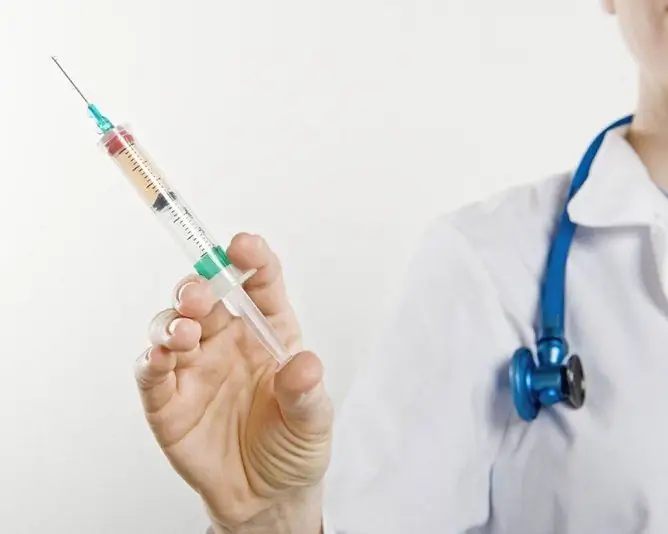- Author Rachel Wainwright [email protected].
- Public 2023-12-15 07:39.
- Last modified 2025-11-02 20:14.
Larigama
Larigama: instructions for use and reviews
- 1. Release form and composition
- 2. Pharmacological properties
- 3. Indications for use
- 4. Contraindications
- 5. Method of application and dosage
- 6. Side effects
- 7. Overdose
- 8. Special instructions
- 9. Application during pregnancy and lactation
- 10. Use in childhood
- 11. In case of impaired renal function
- 12. For violations of liver function
- 13. Use in the elderly
- 14. Drug interactions
- 15. Analogs
- 16. Terms and conditions of storage
- 17. Terms of dispensing from pharmacies
- 18. Reviews
- 19. Price in pharmacies
Latin name: Larigama
ATX code: A11EX; N07X
Active ingredients: thiamine (vitamin B1) [Thiamine (Vitamin B1)] + pyridoxine (vitamin B6) [Pyridoxine (Vitamin B6)] + cyanocobalamin (vitamin B12) [Cyanocobalamin (Vitamin B12)] + lidocaine (Lidocaine)
Manufacturer: LLC "Grotex" (Russia)
Description and photo update: 2020-10-08
Prices in pharmacies: from 174 rubles.
Buy

Larigama is a combined multivitamin preparation containing B vitamins: thiamine (vitamin B 1), pyridoxine (vitamin B 6) and cyanocobalamin (vitamin B 12).
Release form and composition
The drug is produced in the form of a solution for intramuscular (i / m) administration: transparent, color - from pinkish-red to red, has a specific odor made of cardboard together with instructions for the use of Larigama and ampoule scarifier (or without it), 1 package with 5 or 10 ampoules, or 2 or 5 packages with 5 ampoules].
Composition of 1 ml of the preparation:
- active ingredients: thiamine hydrochloride - 50 mg; pyridoxine hydrochloride - 50 mg; cyanocobalamin - 0.5 mg; lidocaine - 10 mg;
- additional components: sodium hydroxide solution 10M - up to pH4-5; potassium hexacyanoferrate (III) - 0.1 mg; sodium polyphosphate - 10 mg; benzyl alcohol - 20 mg; water for injection - up to 1 ml.
Pharmacological properties
Pharmacodynamics
Larigama is a combined multivitamin preparation. Neurotropic B vitamins have a beneficial effect on diseases of the musculoskeletal system and the central nervous system, which are degenerative and inflammatory.
The effectiveness of Larigama is determined by the properties of its constituent vitamins:
- thiamin (vitamin B 1): it plays a key role in the processes of carbohydrate metabolism, which are crucial in metabolic processes in the nervous tissue (it takes part in the conduction of a nerve impulse), and in addition, in the Krebs cycle with subsequent participation in the synthesis of ATP (adenosine triphosphate) and TPP (thiamine pyrophosphate);
- pyridoxine (vitamin B 6): has a vital effect on the metabolism of fats, carbohydrates and proteins, plays a significant role in the process of hematopoiesis, is necessary for the normal functioning of the central and peripheral nervous system. Participates in the synthesis of catecholamines and the transport of sphingosine, which is part of the nerve sheath; provides inhibition processes in the central nervous system and synaptic transmission. The physiological function of both vitamin B 1 and vitamin B 6 is to potentiate the action of each other, which is expressed in the mutual enhancement of the positive effect on the cardiovascular, neuromuscular and central nervous systems;
- cyanocobalamin (vitamin B 12): an important factor in the growth, hematopoiesis and development of epithelial cells, takes part in the synthesis of nucleotides, is necessary for the synthesis of myelin and the metabolism of folic acid;
- lidocaine: promotes the absorption of vitamins, exerting an expanding effect on blood vessels; exhibits a local anesthetic effect at the injection site, which is due to the blockade of voltage-gated sodium channels, as a result of which the generation of impulses along the nerve fibers is reduced.
Pharmacokinetics
Pharmacokinetic characteristics of the active ingredients in Larigama:
- thiamin (vitamin B 1): after i / m administration, it enters the bloodstream, quickly absorbed from the injection site: on the first day of administration at a dose of 50 mg, 15 minutes later, the concentration of the substance was 484 ng / ml; the distribution is uneven, so the content of thiamine in erythrocytes is 75%, in leukocytes - 15%, in blood plasma - 10%. Since thiamine does not accumulate in sufficient quantities, it requires a daily intake of it into the body. Penetrates through the placental and blood-brain barriers, is determined in breast milk. Thiamine is excreted by the kidneys: in the α-phase - after 0.15 hours, in the β-phase - after 1 hour, in the terminal (final) phase - within two days. The main metabolites of thiamine are pyramine, thiamincarboxylic acid, and other metabolites that could not be determined. Compared with all other vitamins, thiamine is stored in organs and tissues in the lowest concentrations. Approximately 30 mg of thiamine is contained in the body of an adult, of which 80% is in the form of thiamine pyrophosphate, 10% is thiamine triphosphate, the rest is in the form of thiamine monophosphate;
- pyridoxine (vitamin B 6): after intramuscular injection it enters the bloodstream, is rapidly absorbed from the injection site and is widely distributed, acting as a coenzyme after phosphorylation of the CH 2 OH group in the fifth position. Within 80% of pyridoxine binds to blood plasma proteins. Vitamin B 6 is distributed throughout all organs and tissues, crosses the placental barrier, and is detected in human milk. It accumulates in the liver, where it is oxidized to 4-pyridoxinic acid, which is excreted in the urine a maximum of 2-5 hours after absorption. The body of an adult contains 40-150 mg of pyridoxine (vitamin B 6); approximately 1.7-3.6 mg of the substance is eliminated daily, and the replenishment rate is from 2.2 to 2.4%;
- cyanocobalamin (vitamin B 12): after i / m administration, it forms a bond with transport proteins (transcobalamins I and II) and is transferred to various tissues. The maximum concentration of the substance after i / m administration is fixed after 60 minutes. It binds to blood plasma proteins by 90%. Penetrates the placental barrier, is determined in human milk. Metabolism mainly occurs in the liver with the formation of the active form of cyanocobalamin - adenosylcobalamin. It is deposited in the liver, enters the intestines with bile, after which it is again absorbed into the blood (enterohepatic recirculation). Cyanocobalamin has a long half-life, excretion is carried out mainly through the intestines - 50%, and also through the kidneys - from 7 to 10%. In case of impaired renal function, from 70 to 100% of pyridoxine is excreted through the intestines, up to 7% through the kidneys;
- lidocaine: when administered intramuscularly, 5-15 minutes after injection, the maximum concentration of lidocaine in the blood plasma is noted. The connection with plasma proteins is 60 to 80% (depending on the dose). The distribution of the substance in organs and tissues with good perfusion (lungs, heart, kidneys, liver, then muscle and adipose tissue) is rapid - within 6-9 minutes. Lidocaine crosses the placental and blood-brain barriers; up to 40% is determined in breast milk, compared with the concentration of the substance in the mother's blood plasma. Metabolism occurs in the liver with the participation of microsomal enzymes, in the process metabolites are formed - glycinexylidide and monoethylglycinexylidide, exhibiting pharmacological activity. The half-life of glycinexylidide is 10 hours, monoethylglycinexylidide - 2 hours. In patients with liver disease, the metabolic rate decreases. Lidocaine is excreted from the body by the kidneys, mainly in the form of metabolites, unchanged - up to 10%.
Indications for use
Larigama is used in the complex therapy of the following diseases / conditions:
- plexopathy;
- mono- and polyneuropathy of various origins;
- sciatica;
- dorsalgia;
- radicular syndrome caused by degenerative changes in the spine.
Contraindications
- CHF (chronic heart failure) in the stage of decompensation; AHF (acute heart failure);
- age under 18 years (due to the lack of data on the safety and efficacy of the drug);
- pregnancy;
- lactation period (breastfeeding);
- hypersensitivity to the components of Larigama.
Larigama, instructions for use: method and dosage
Larigam's solution is intended exclusively for intramuscular administration. The injections are performed deep into the gluteus muscle.
The recommended dosage regimen for severe pain syndrome is 2 ml daily for 5-10 days. In the future, they switch either to taking an oral dosage form (inside), or to more rare injections of Larigama with a frequency of application 2-3 times a week for 2-3 weeks with the possible continuation of treatment with a dosage form for oral administration.
On the part of the doctor, weekly monitoring of therapy is required. The doctor determines the duration of treatment individually, based on the severity of the symptoms of the disease in each case.
It is recommended to switch to therapy with the drug in a dosage form intended for oral administration as soon as possible.
Side effects
When using Larigama, the following side reactions from systems and organs are possible:
- central nervous system: with an unknown frequency (it is impossible to determine the frequency of development of adverse reactions on the basis of available data) - confusion, dizziness;
- immune system: rarely (≥ 0.01% and <0.1%) - allergic reactions (shortness of breath, skin rash, Quincke's edema, anaphylactic shock);
- heart and blood vessels: extremely rare (<0.01%) - tachycardia; with an unknown frequency - arrhythmia, bradycardia;
- musculoskeletal and connective tissue: with an unknown frequency - convulsions;
- skin and subcutaneous tissues: extremely rarely - urticaria, itching, acne, increased sweating;
- gastrointestinal tract: with an unknown frequency - vomiting;
- general disorders and disorders at the injection site: with an unknown frequency - irritation at the injection site of Larigama is possible; in case of overdose or rapid administration, systemic reactions * may occur.
* Systemic reactions such as vomiting, arrhythmia, bradycardia, confusion, dizziness and convulsions can develop when the dose is exceeded or the solution is quickly administered (for example, due to injection into tissues with abundant blood supply or in case of unintentional intravascular injection).
The aggravation of any of the adverse reactions indicated in this instruction or the development of new side effects should be reported to the attending physician.
Overdose
An overdose of the drug can manifest itself as vomiting, arrhythmia, bradycardia and, possibly, systemic reactions such as confusion, dizziness, convulsions.
With the development of any signs of an overdose, Larigama therapy is immediately canceled, if necessary, symptomatic treatment is prescribed.
special instructions
Larigam's solution is intended exclusively for intramuscular administration, and therefore it is important not to allow it to enter the vascular bed. If the drug was accidentally injected intravenously (IV), the patient must be monitored by a specialist, or hospitalized, based on the severity of the symptoms.
With drug therapy for more than 6 months, neuropathy may develop.
Influence on the ability to drive vehicles and complex mechanisms
There is no data on whether Larigama affects the ability to drive vehicles and engage in potentially hazardous activities that require quick psychomotor reactions and increased concentration of attention. However, the possibility of developing side effects from the central nervous system, such as dizziness, must be considered and caution must be exercised.
Application during pregnancy and lactation
For pregnant and breastfeeding women, drug therapy is contraindicated.
Pediatric use
For patients under the age of 18, the appointment of Larigama is contraindicated.
With impaired renal function
Limitations in the use of Larigam for patients with impaired renal function have not been established by the manufacturer.
For violations of liver function
Limitations in the use of Larigam for patients with impaired hepatic function have not been established by the manufacturer.
Use in the elderly
In elderly patients, Larigam is used according to the dosage regimen indicated in the instructions.
Drug interactions
Thiamine (vitamin B 1) in solutions containing sulfites completely decomposes, as a result of which its decomposition products inactivate the action of other vitamins.
Thiamine is incompatible with reducing and oxidizing compounds, including tannic acid, carbonate, mercury chloride, iron-ammonium citrate, acetate, iodide, as well as dextrose, metabisulfite, benzylpenicillin, riboflavin and phenobarbital.
The breakdown of thiamine is accelerated by copper. It also loses its effectiveness as the pH rises to> 3.
When used simultaneously with levodopa, pyridoxine (vitamin B 6), taken in therapeutic doses, is able to weaken the effect of levodopa (reduce its antiparkinsonian effect). In addition, the interaction of pyridoxine with isoniazid, penicillamine and cycloserine was noted.
Cyanocobalamin (vitamin B 12) is incompatible with heavy metal salts and ascorbic acid.
Parenteral lidocaine, with the additional use of epinephrine / norepinephrine, may increase adverse cardiac reactions.
The drug interaction of lidocaine with sulfonamides was noted.
In case of an overdose of local anesthetic agents, it is prohibited to additionally use epinephrine / norepinephrine.
Analogs
The analogues of Larigam are Vitagamma, Kombilipen, Kombilipen NEO, Milgamma, Trigamma, KompligamV, Vitaxon, Sertogamma, Binavit, Elligamin, etc.
Terms and conditions of storage
Store in a place inaccessible to children at a temperature of 2-8 ° C.
The shelf life is 3 years.
Terms of dispensing from pharmacies
Dispensed by prescription.
Reviews about Larigam
On the Internet, most of the reviews about Larigam are positive. Users characterize the drug as affordable, effective, and reliable. In the complex therapy of neurological diseases, it quickly relieves pain and improves the general well-being of the patient.
In rare cases, they mention the lack of effect when using a vitamin complex. Also, some patients complain about the painfulness of Larigama injections.
The price of Larigama in pharmacies
The price of Larigama, a solution for intramuscular injection, for a package of 5 ampoules of 2 ml, is 178-312 rubles, for a package containing 10 ampoules of 2 ml, 238-545 rubles.
Larigama: prices in online pharmacies
|
Drug name Price Pharmacy |
|
Larigam 100 mg + 100 mg + 1 mg / 2 ml solution for intramuscular injection 2 ml 5 pcs. 174 r Buy |
|
Larigam 100 mg + 100 mg + 1 mg / 2 ml solution for intramuscular injection 2 ml 10 pcs. 245 RUB Buy |

Maria Kulkes Medical journalist About the author
Education: First Moscow State Medical University named after I. M. Sechenov, specialty "General Medicine".
Information about the drug is generalized, provided for informational purposes only and does not replace the official instructions. Self-medication is hazardous to health!






